MVP software development. A guide on how to verify your idea with a Minimum Viable Product
Doing business is a risky thing. We all know that. And no matter what we do, risk cannot be taken out of business, so it’s better to manage it wisely.
And this is a clue of MVP development: to manage the risk by building early-stage products aimed to test business ideas. This way you can check if your product is able to fit into the market, and then develop it further.
Nonetheless, the introduction of a Minimum Viable Product to the target market is a demanding process so it’s worth taking a look at how it should go. Additionally, if you are a business owner who belongs to the cautious group that tests, verifies, and analyzes before doing, then this MVP development article, is the right fit for you.
What you will learn
- Definition of Minimum Viable Product
- The goal of building an MVP
- How to build an MVP: a comprehensive guide
- MVP obstacles
- Our success story of building an MVP
- What to measure after launch?
- Summary
What is a Minimum Viable Product?
Term MVP refers to the product—e.g. application or website—that is able to attract potential customers with a minimum feature set. In other words, a successful MVP is a marketable product that delivers exceptional value to its target users through its limited but key features.
MVP development seems to be then a fairly targeted process because it is about giving the most important but nothing more.
From this, it follows that the whole concept of the MVP development process can be pretty demanding as the success criteria are relentless. MVP must meet the market demands —solve target users’ problems and consider their needs—with the least effort.

Why build an MVP?
First of all, to test and validate the product concept before jumping on deep water which undoubtedly is developing a full-fledged product. Companies decide on verifying their product idea with MVP for several reasons:
Time
MVP project takes a significantly shorter time so the product can be launched on the market relatively quickly. It means a faster start to the testing stage.
Money
MVP development costs less money than building the final product. It requires you to prioritize features so the marketable product has only these essential ones. Developing less complex products means a smaller budget spent.
Arouse interest
Getting funds to build a digital product is not easy, and all startups looking for investors can confirm the point. Therefore, MVP development is a great way to prove that there is a demand for the product. Collecting positive feedback from early adopters can be a convincing ace in a hole and a clear sign that people want the product. Showing investors the metrics obtained due to MVP validates that the business idea is achievable.
The conclusion is that the MVP development process gives a chance to find out if the concept—software idea—is valid and has a chance of success, and all of that happens with a relatively small budget and in a shorter time.
How to build an MVP: a step-by-step guide
The journey of building a Minimum Viable Product consists of many steps and preparations you need to take as a business owner. Below you find a more detailed list of what is beneficial to perform when developing an MVP. Of course, it happens that the steps can be taken in a different order, nonetheless, all the steps are worth considering in the MVP process.
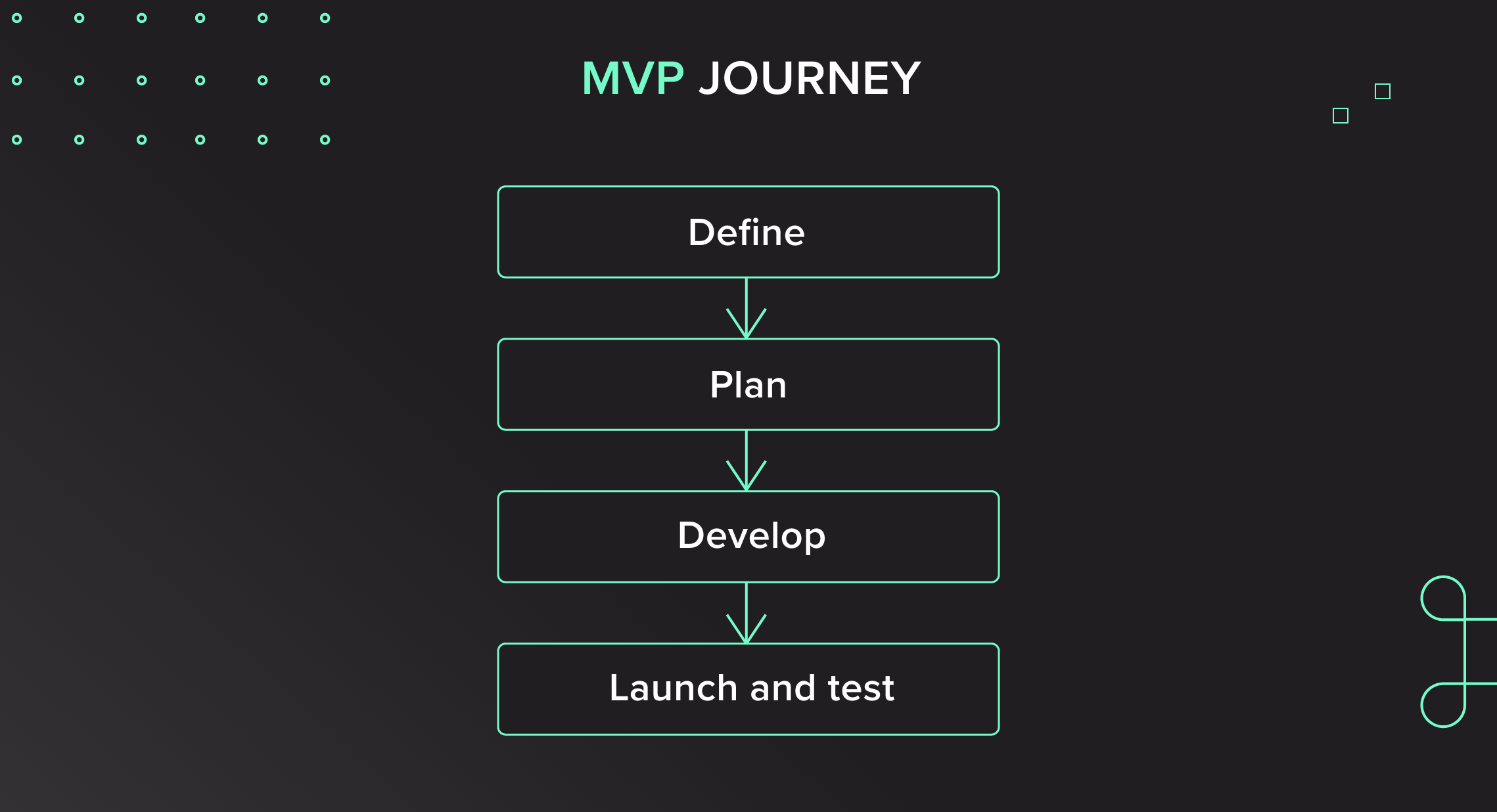
Define stage
At the very beginning take a closer look at your idea and what it can address.
Business objectives
- Determine the gap in the market and the problem within it your digital product will solve.
- Know why you create the product.
- Define the metrics that will allow you to verify an MVP performance.
Plan stage
The more and better you plan, the easier will the collaboration with the product team. Of course, you can also hire a software company that will do most of the planning, anyway your support will be necessarily needed.
Market research
- Look for the competition—the one existing, but also the one who failed.
- Do careful competitor research. If possible, analyze their workflow, strong and weak points, and how they market the product.
- Plan how your product will stand out from the competition.
Target audience
- Investigate who is your target audience.
- Create main user personas to make the software engineering team more aware and emphatic of the target audience.
User satisfaction
- Form “user journeys” to be aware of tasks users will perform with an existing similar product or having no product at all (alternative tasks to achieve a goal).
- Define what are the success criteria for completing users’ tasks.
- Identify what part of user stories can be problematic—pain points, and how to counteract them.
Initial Product Backlog
- Think through the results of user analysis: needs, problems, actions user completes.
- Define user stories focusing on tasks: who, what the object wants to do, and why it’s needed.
- Update the backlog with user stories which can be defined as a result of competition analysis and research on user feedback on competitors’ products.
Remember: You will perform the Product Backlog creation with a product team, but the more you will have already done, the easier will be to agree on the final version with the team.
MVP main features list
- Rank the listed user tasks (product requirements) from the most to the least important ones.
- Determine the major tasks that your Minimum Viable Products must deliver.
- Assure yourself that all the major tasks have come from user analysis —problems, needs, actions. If the critical feature is not user research-driven, it shouldn’t be a major feature.

Develop stage
Having a good tech partner for the MVP development process is of paramount importance. You can choose a development company earlier on before you start with market research. If your chosen tech partner is a full development cycle company, they can also help you with user research.
Choose development team
- Decide on an experienced partner.
- Ensure that they follow industry-standard practices.
- Check if they work in Agile as a software development methodology — it’s the best one.
- Go through their reviews and projects they delivered— what technologies they are good at.
Decide on a tech stack
- Discuss with your partner the technology stack focusing on the possibility of building an MVP but also the final product.
- Make a decision.
Confirm the budget in relation to the MVP functionality
- Decide with the team on the Product Backlog (or build it together if you don’t have one yet) which presents and prioritizes MVP functionality.
- Discuss funds for after-launch activities.
- Be sure that the software partner agrees on the budget and functionalities to build.
Start from validating the IA
- Before starting the work of the design team, confirm the information architecture to be sure that everything (main MVP features) is included in it.
- Check with the team that proposed IA will be able to scale up in the future.
Plan the product with wireframes and prototypes
- Wireframes allow the UX designer to incorporate user stories into the solution, so all tasks from the backlog will be able to be completed.
- Use prototypes to test if proposed solutions work—for you and for the users.
- Based on user opinions on usability decide with the designer what improvements to make.
- Be assured that the user flow is intuitive and effortless, and the interface is straightforward and predictable.
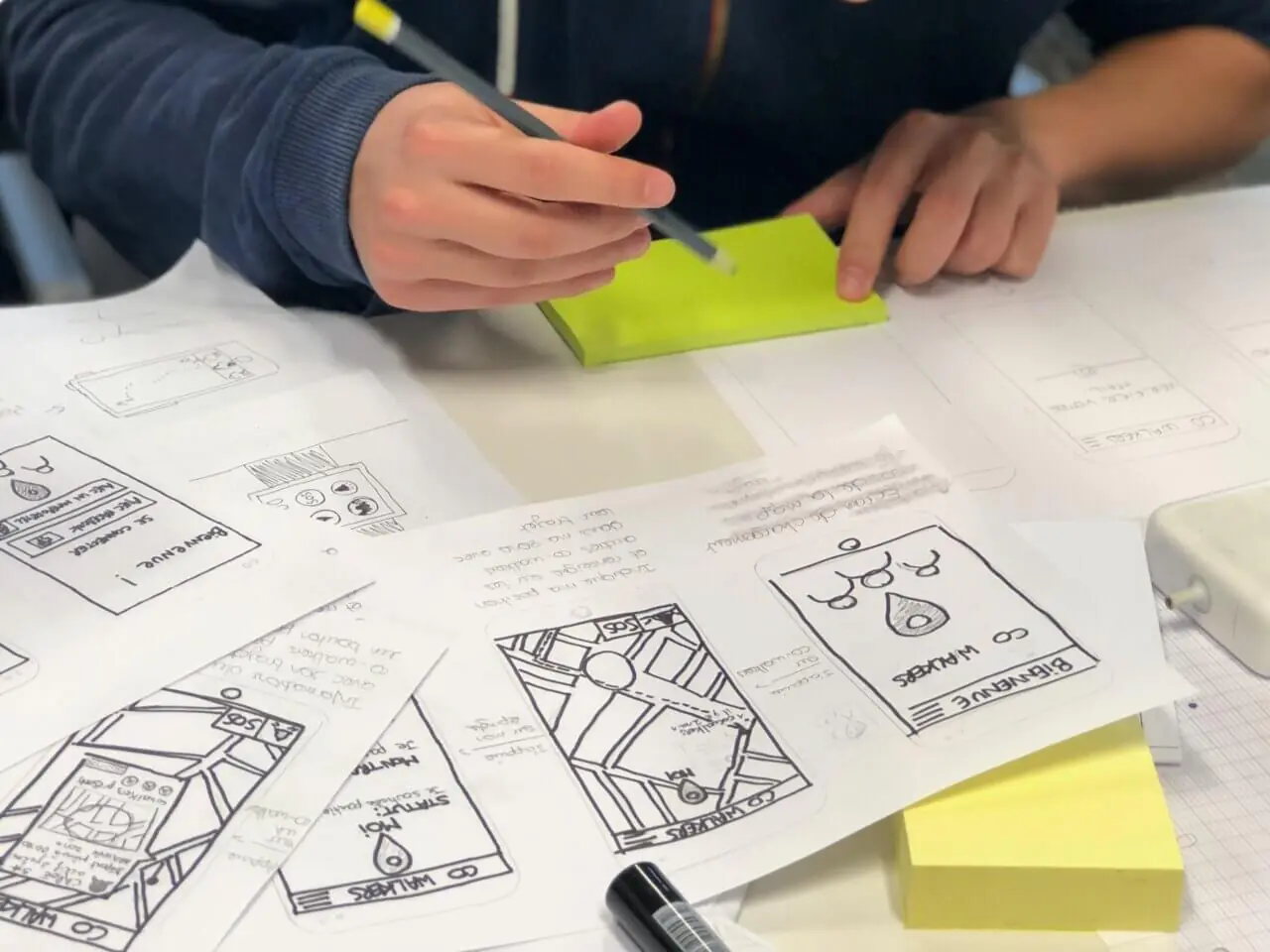
Confirm your brand and style guidelines
- Refine the style and visual identity you want to use in your product.
- Cooperate with designers to agree on key visual principles which your product will reflect.
- Later on, focus on incorporating the product style and branding into MVP development.
Work on Minimum Viable Product security
- Know the topic and define compliance requirements should your future product stand for.
- Take care of the product safety framework.
- Cooperate with the development team to provide integration of security and compliance requirements into the product.
Be engaged during the development process
- Involve in every stage of the iterative process so you will be always up to date with the status.
- Ask the Product Owner for reports.
- Give regular feedback so the team will know if they move forward in the right direction.
- Take part in meetings and share your business perspective.
If you are interested in the topic of how to support the Agile team in delivering projects in Scrum, read our article in which you can find direct tips and useful knowledge: Agile Software Development: a guide for stakeholders
MVP launch and testing phase
This phase can be tricky for your peace of mind. On the one hand, you know that many more could be done to make your actual product better fitted to the market, but contrastingly you know that MVP development is about to bring the needed minimum. So you have to finish the play and launch the product.
It’s not without reason that the most popular quote about MVP development is the one about MVP deficiency.
” If you are not embarrassed by the first version of your product, you’ve launched too late” — Reid Hoffmann
Introduce MVP to the market
- Confirm the users to whom the MVP is directed—the audience you previously indicated.
- Start communicating to your audience that they can use the product with a focus to highlight the benefits.
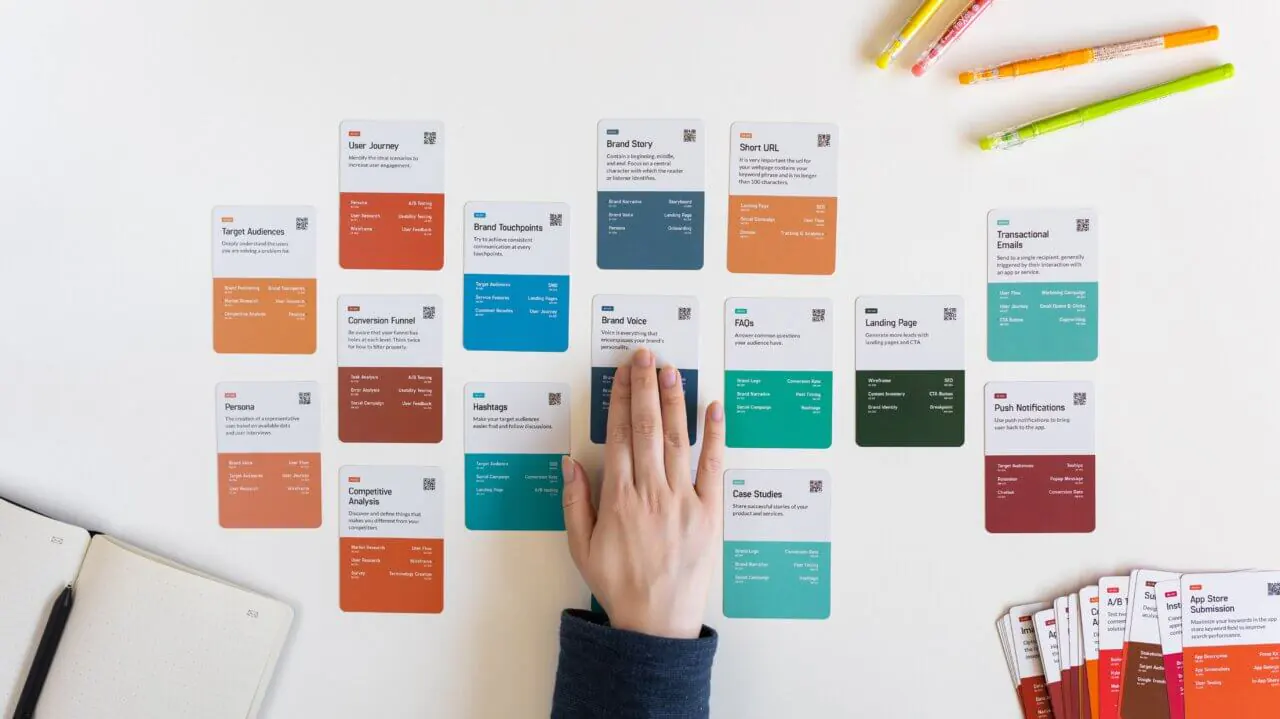
Confirm the performance metrics and start tracking
- If you already defined the MVP metrics you can refine them with a team and make a final decision.
- Start to track and analyze the metrics.
Metrics that can help you to validate your MVP and an idea it stands for:
- New accounts
- Percentage of active users
- Growth ratio
- Traffic as well the user engagement
- ROI
- Client Acquisition Cost (CAC)
- CLV indicates how much time a user spends using a product
- Churn rate
Collecting user feedback
- Plan to obtain feedback regarding problem-solving and critical users’ paths.
- Take care that giving feedback is a convenient thing for users.
- Gather information and make them a useful report to work with further on.
What possibly could go wrong with MVP development?
It may seem that since the MVP is mainly a way to test an idea and not a full-fledged product, it’s fairly simple to build. Unfortunately, despite many ready-made recipes on how to build an MVP, the process itself, like everything in software development, is complex. Therefore many things can go wrong. However, there are a few particularly worth paying special attention to. Most of them are linked with users’ feedback.
Address the incorrect market need
Focus on a proper market need is the most basic rule, every digital product has to follow. Well-built, aesthetic, secure products are not enough if they won’t give consumers unique value. Successful MVP resolves problems uniquely. It must provide something that market doesn’t have but yet it’s needed.
Thus, the hypothesis that MVP addresses must be well-thought through but also accurately defined, so there is no room for various interpretations.
Helpful questions worth asking:
- Who do you build an MVP for?
- What problem does your product solve?
- What will make your MVP unique?

Lack of testing on prototypes
One of the main aspects software development relies on is testing. Each built solution is aimed to serve people, so users have to check if the solutions meet their needs. Pretty logical, isn’t it?
A prototype is a way the team can test if the proposed solution does its job. With an interactive (clickable) presentation of the product, you as a business representative, and users can click through the solution and evaluate the experience.
Prototype testing is then the best way to check how the solution works and to introduce changes if needed before the coding begins. Therefore, a lack of testing on a clickable prototype means a wasted chance to see if the product works the way it was intended.
The wrong target audience for testing
Having feedback is essential, but having feedback from the group which actually represents the target audience is a must. Asking for testing the prototype by people who don’t belong to the actual future users’ group is a significant mistake. You can do this, but only as an addition. To get valuable evaluation ask for the opinion of people from the defined audience group. Make an effort and reach actual users—through social media, forums, digital groups, or dedicated platforms that help to reach a defined group of users. The choice is yours.
Having too narrow feedback
Ok, so you are testing a prototype of your Minimum Viable Product with target users, collecting feedback, and synthesizing it to make improvements. The question is: what kind of feedback should you have to be the most valuable? The answer is various.
The most beneficial will be to obtain both—qualitative and quantitive—feedback to broaden your perspective on the product’s usability.
Quality data are collected through in-depth interviews and observations. Mostly, they answer questions WHY. Quality feedback gives an overall perception of how the user feels about the product—the design, user flow, etc. Conducting interviews makes it possibile for users to share their ideas of how something should work to resolve their pain points more efficiently.
Quantity data, in turn, give answers to the question of how many or how much: how many errors the user made during achieving the goal, how much time it took the complete users to flow, etc.
Both data are indispensable to get the most valuable insights into users’ experience while using Minimum Viable Product. Then there will be left only (or as much as) a decision on which conclusions we want to take into account and make changes to MVP based on them.

Not being able to say stop
Building an MVP means delivering unique value with minimum features and checking if it clicks. Of course, this is a shortcut because, as you know, MVP structure is much more complicated. Still, however, it’s all about simplicity and testing the idea. Therefore, chasing perfection when building an MVP may turn out to be a trap. Mistakes and the not ideal solutions used are inevitable. And the minimum will always be a minimum and nothing more.
” The lesson of the MVP is that any additional work beyond what was required to start learning is waste, no matter how important it might have seemed at the time. ” — Eric Ries source
Choosing the wrong project development method
There’re a few methods of delivering software projects, but at Software Things we are advocates of Agile development. Agile is about embracing changes and flexibility but most of all, it helps to monitor the value behind the features. The methodology and its frameworks encourage the team to ask questions about why we build new features. This, in the MVP case, is extremely useful. One-of-a-kind values make the app unique and that is one of the MVP aims.
What after MVP launch?
MVP is a bit like experimenting and the real adventure begins when the product hits the market. The priorities must change, and all the effort should go into checking, analyzing, and drawing the right conclusions.
First of all, the well-chosen metrics should play a major role. They should be adapted to the specifics of the product or industry or goals to be achieved with the next product update. As already stated the choice is wide: active users, number of downloads, revenue per user, CAC, retention rate, and many more. Think over the issue as the clue is to focus on the useful indicators.
Most of all, be curious and open to feedback. Do not take the criticism personally, and do not become attached to the solutions worked out. It’s more than certain, that the MVP will not be perfect and will require work to be refined and developed later. It’s important to take the feedback into account but not to be discouraged by critics. Besides, there is no better motivator and development aid than constructive feedback that uncovers weaknesses and allows you to improve your product.
Our Minimum Viable Product – blood donation app
We had an opportunity to develop an MVP for a medical client RCKiK in Katowice – the app for blood donors called ’Bliscy Krewni’. The already described golden rules for building an MVP were our guide, and what else can we say, it turned out to be good for us, the client, and the product. We managed to deliver MVP that responded to users’ pain points in a unique way and keep the established MVP budget.
What were the most important principles that we implemented and which helped us to make a good MVP?
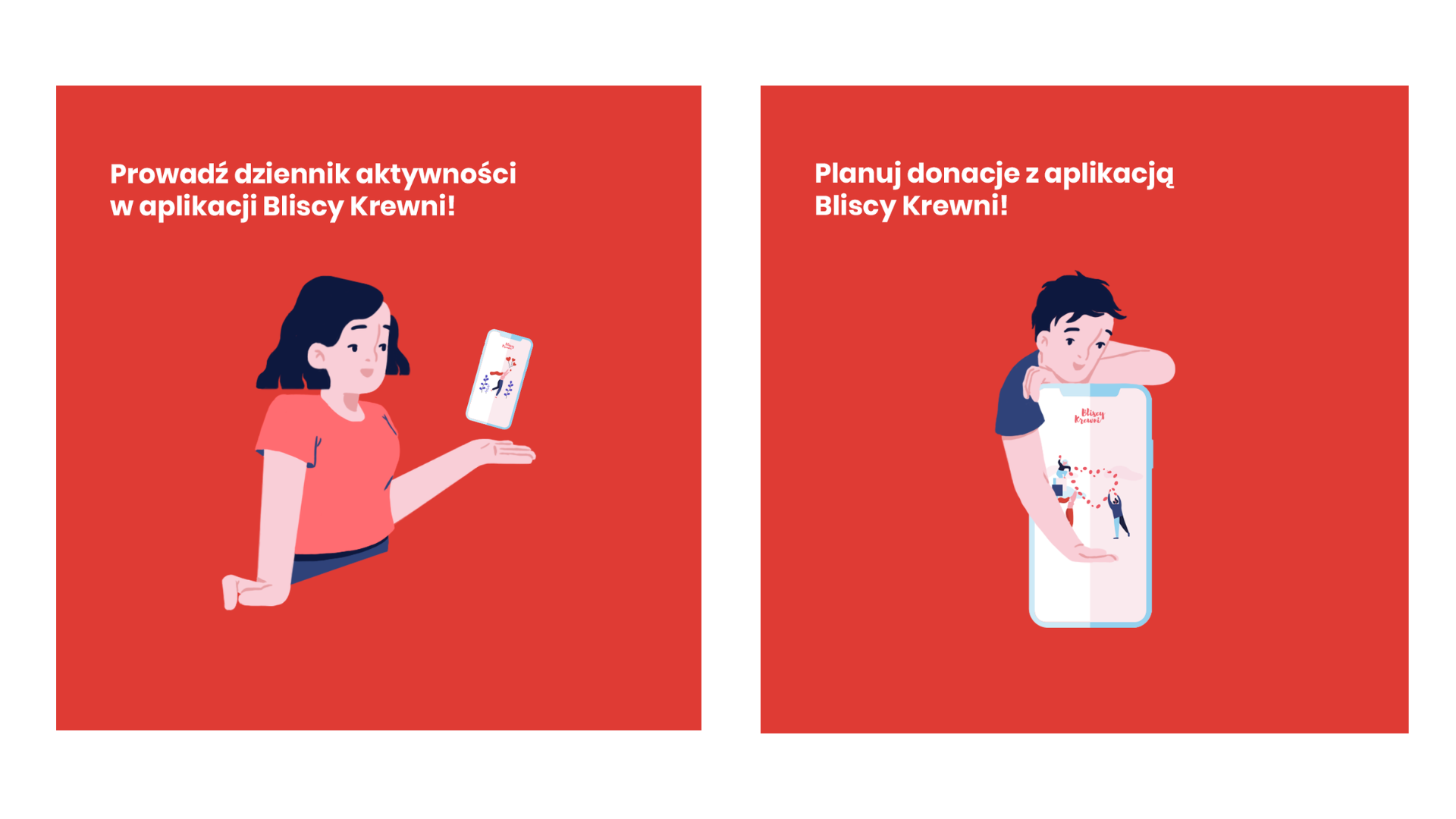
Careful user and market research
Our project’s core was the target audience. The good relationship with the client allowed us to reach actual recipients and examine their needs and problems. As a result, we had a clear idea of what was the main users’ problems and other significant needs. This helped us to establish a plan: what will the MVP deliver and what can be planned to implement in further development.
Testing solutions with actual recipients
Before the development stage began we asked users to test our solutions. The conducted usability studies allowed us to check how recipients felt about the main user flow as well as to examine other features. Or way for good testing was to ask users to complete tasks, but also to get to know their overall opinion regarding features and the product as a whole.
Budget management
During the whole software development process, we kept in mind that our goal was to deliver an MVP offering needed minimum and that the client had a limited budget. Additionally, we were already thinking about further development and the budget needed. That’s why we’ve decided on using solutions allowing for money saving like building an app on React Native so we could split the code and reach with it the multiple platforms.
Plan for collecting feedback after the MVP launch
There were a few indicators of the app getting into the market but we also wanted to know what exactly felt the users. We have made a plan to collect opinions from platform reviews – iOS and Android users, but also to communicate with users through groups on FB and surveys. The next months after the launch we were successively collecting opinions and planning changes and improvements. This way we were ready for the app’s next update.
The examination of audience opinions was a thoughtful process. As we delivered Bliscy Krewni MVP with our sister brand Kava —a creative agency — we had an impact on shaping the marketing campaign. Therefore, one of the steps involved in the communication plan was to acknowledge users how needed they were to improve the product. In this way, we built their commitment, and then they willingly shared their opinions.
Interested in the story of the Bliscy Krewni app? Be sure to check out the full journey of developing an MVP app in our case study.
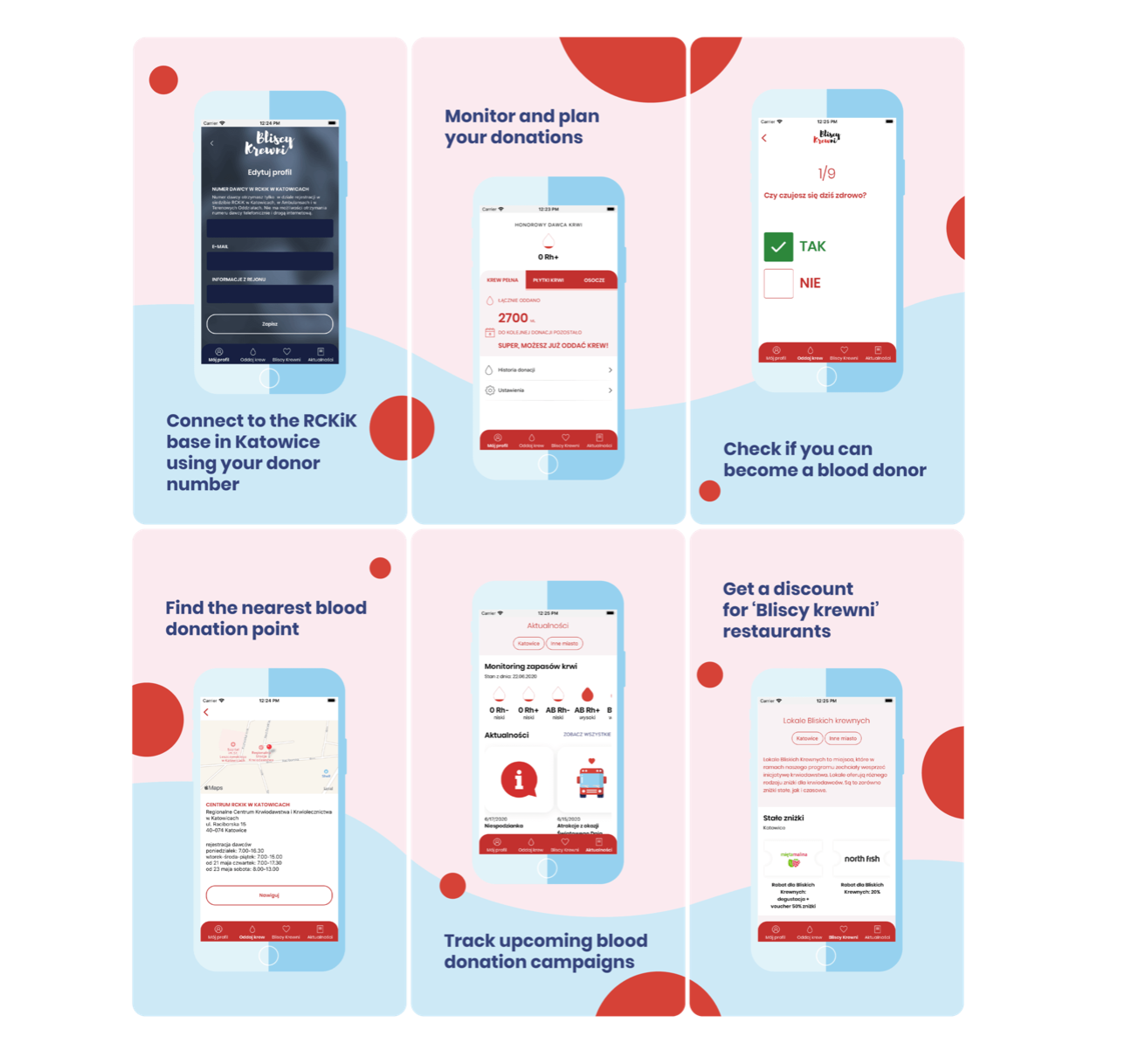
Find MVP development partner
Many startups fail because they often provide expensive products that don’t meet potential customers’ needs. Building an MVP before the full-grown product is a great practice that fits perfectly into the wise management of business ideas and risk. MVP allows you to verify ideas and carefully study the market behavior of the product. And customers’ problems are the best direction indicators for the further development of the MVP.
Of course, for a successful project, you need a good team that knows how to deliver MVPs. Choose an experienced development partner that will help you take care of the product and relieve you of many tasks. In fact, a business doesn’t need to know how to build an MVP. It’s enough to have a trusted team for this. Nevertheless, it’s always worth knowing more to have the power to ask questions, and learn the process, so that further product development will be easier.
If you want to build an MVP that actually meets users’ needs but also fits into the budget, speak to us. Let’s start with a brief conversation, during which we will explain how we operate and what we can do for you.
Here you can contact us and take your first step in the MVP journey.
Read more about

Contact
Benefit from a free consultation
Ready to turn your software idea into reality? Collaborating with us means benefiting from our experience, expertise, and cutting-edge technology to bring your vision to life. Simply share a few words with us about your idea, and our expert will reach out to ask the ring questions.


